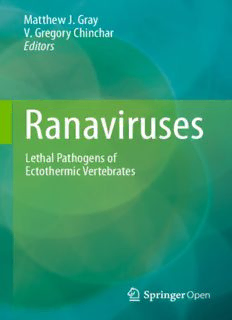
Ranaviruses: Lethal Pathogens of Ectothermic Vertebrates PDF
Preview Ranaviruses: Lethal Pathogens of Ectothermic Vertebrates
Matthew J. Gray V. Gregory Chinchar Editors Ranaviruses Lethal Pathogens of Ectothermic Vertebrates Ranaviruses Matthew J. Gray (cid:129) V. Gregory Chinchar Editors Ranaviruses Lethal Pathogens of Ectothermic Vertebrates Editors Matthew J. Gray V. Gregory Chinchar Center for Wildlife Health Department of Microbiology Department of Forest, Wildlife, and Fisheries University of Mississippi Medical Center University of Tennessee Jackson , MS , USA Knoxville , TN , USA ISBN 978-3-319-13754-4 ISBN 978-3-319-13755-1 (eBook) DOI 10.1007/978-3-319-13755-1 Library of Congress Control Number: 2015935731 Springer Cham Heidelberg New York Dordrecht London © The Editor(s) (if applicable) and the Author(s) 2015 . The book is published with open access at SpringerLink.com Open Access This book is distributed under the terms of the Creative Commons Attribution Noncommercial License, which permits any noncommercial use, distribution, and reproduction in any medium, provided the original author(s) and source are credited. All commercial rights are reserved by the Publisher, whether the whole or part of the material is concerned, specifi cally the rights of translation, reprinting, reuse of illustrations, recitation, broadcasting, reproduction on microfi lms or in any other physical way, and transmission or information storage and retrieval, electronic adaptation, computer software, or by similar or dissimilar methodology now known or hereafter developed. T he use of general descriptive names, registered names, trademarks, service marks, etc. in this publication does not imply, even in the absence of a specifi c statement, that such names are exempt from the relevant protective laws and regulations and therefore free for general use. T he publisher, the authors and the editors are safe to assume that the advice and information in this book are believed to be true and accurate at the date of publication. Neither the publisher nor the authors or the editors give a warranty, express or implied, with respect to the material contained herein or for any errors or omissions that may have been made. Printed on acid-free paper Springer International Publishing AG Switzerland is part of Springer Science+Business Media (www.springer.com) R anaviruses are a group of emerging pathogens responsible for mass die-offs of amphibians, fi sh, and reptiles in captive and wild populations across the globe. Global commerce of ectothermic vertebrate species and stressors may be contributing to emergence of these pathogens. Photo credits (c lockwise from top left ): Matthew Allender, Nathaniel Wheelwright, Matthew Neimiller, Jonathan Kolby, Yi Geng, Yi Geng, Jonathan Kolby, and Rolando Mazzoni. Artwork by Jeanne Jones. v Contents Introduction: History and Future of Ranaviruses ....................................... 1 Matthew J. Gray and V. Gregory Chinchar Distribution and Host Range of Ranaviruses ............................................... 9 Amanda L. J. Duffus , Thomas B. Waltzek , Anke C. Stöhr , Matthew C. Allender , Michael Gotesman , Richard J. Whittington , Paul Hick , Megan K. Hines , and Rachel E. Marschang Ranavirus Taxonomy and Phylogeny ............................................................ 59 James K. Jancovich , Natalie K. Steckler , and Thomas B. Waltzek Ranavirus Ecology and Evolution: from Epidemiology to Extinction ....... 71 Jesse L. Brunner , Andrew Storfer , Matthew J. Gray , and Jason T. Hoverman Ranavirus Replication: Molecular, Cellular, and Immunological Events ............................................................................. 105 James K. Jancovich , Qiwei Qin , Qi-Ya Zhang , and V. Gregory Chinchar Ranavirus Host Immunity and Immune Evasion ........................................ 141 Leon Grayfer , Eva-Stina Edholm , Francisco De Jesús Andino , V. Gregory Chinchar , and Jacques Robert Comparative Pathology of Ranaviruses and Diagnostic Techniques ......... 171 Debra L. Miller , Allan P. Pessier , Paul Hick , and Richard J. Whittington Design and Analysis of Ranavirus Studies: Surveillance and Assessing Risk .......................................................................................... 209 Matthew J. Gray , Jesse L. Brunner , Julia E. Earl , and Ellen Ariel Index ................................................................................................................. 241 vii Contributors Matthew C. Allender Department of Comparative Biosciences, College of Veterinary Medicine , University of Illinois , Urbana , IL , USA Francisco De Jesús Andino D epartment of Microbiology and Immunology, University of Rochester Medical Center , Rochester , NY , USA Ellen Ariel College of Public Health, Medical and Veterinary Sciences, James Cook University , Townsville , QLD , Australia Jesse L. Brunner School of Biological Sciences , Washington State University , Pullman , WA , USA V. Gregory Chinchar Department of Microbiology , University of Mississippi Medical Center , Jackson , MS , USA Amanda L. J. Duffus Department of Biology , Gordon State College , Barnesville , GA , USA Julia E. Earl N ational Institute for Mathematical and Biological Synthesis, University of Tennessee , Knoxville , TN , USA Eva-Stina Edholm Department of Microbiology and Immunology , University of Rochester Medical Center , Rochester , NY , USA Michael Gotesman D epartment of Infectious Diseases and Pathology, College of Veterinary Medicine , University of Florida , Gainesville , FL , USA Matthew J. Gray C enter for Wildlife Health, Department of Forestry, Wildlife and Fisheries , University of Tennessee , Knoxville , TN , USA Leon Grayfer D epartment of Microbiology and Immunology, U niversity of Rochester Medical Center , Rochester , NY , USA Paul Hick Faculty of Veterinary Science , University of Sydney , Sydney , NSW , Australia ix
Description: